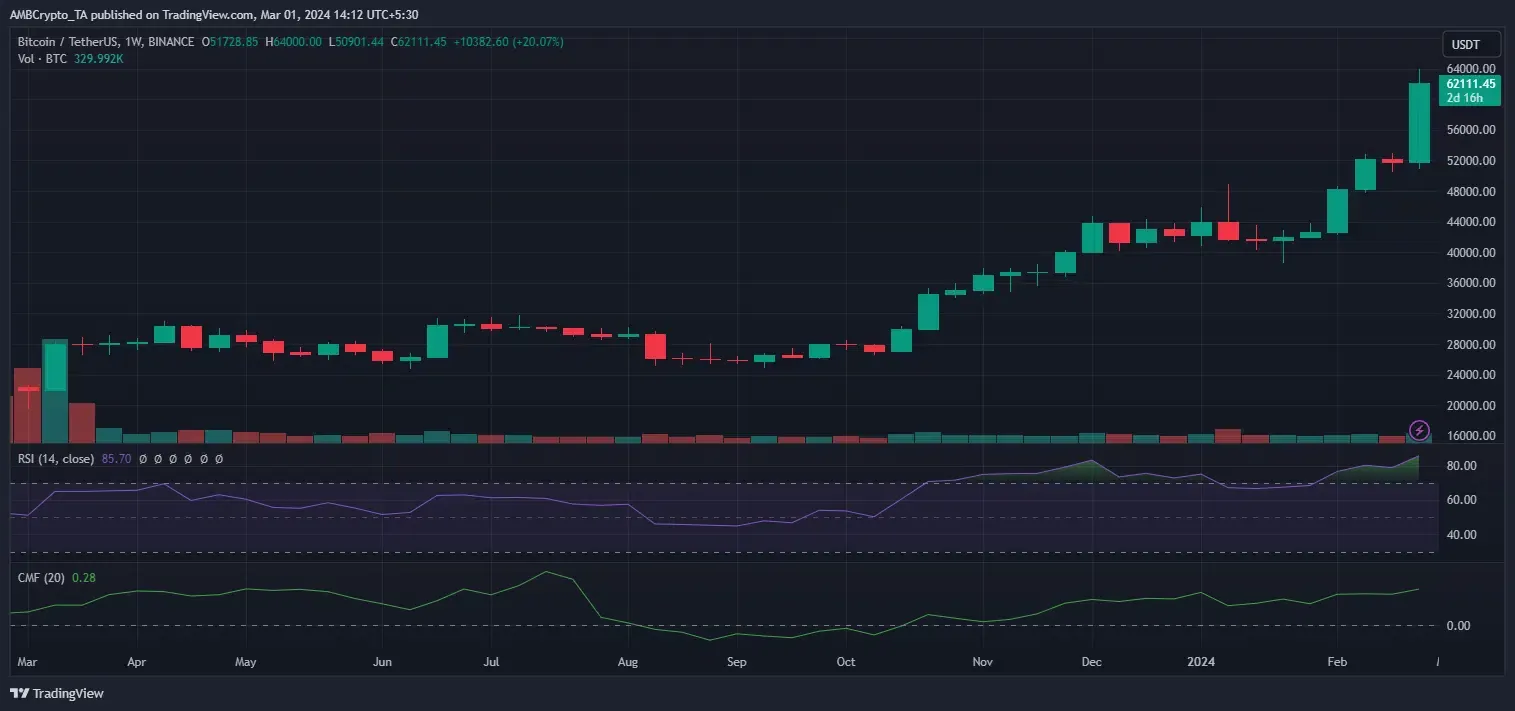How Investors Should Play the Upcoming Bitcoin Halving: Expert Advice
Bitcoin: Halving or halving not? Explore the Bitcoin halving mystery with expert guidance on capitalizing on potential gains, mitigating risks, and strategically growing your portfolio.

As the Bitcoin (BTC) halving event draws nearer, investors and enthusiasts alike are brimming with anticipation. This significant occurrence, which slashes the reward for mining new blocks in half every four years, triggers substantial ripples across the cryptocurrency market. However, investors often wonder how they can play to profit off of the upcoming Bitcoin halving.
In this blog, we’ll delve into the core of how investors should play the upcoming Bitcoin halving. From understanding the fundamentals to strategies for capitalizing on market movements, we’ll provide valuable insights to help investors make informed decisions regarding their digital gold investments.
2024 Bitcoin halving: What is different?
Historical data and fundamental analysis indicate a positive correlation between Bitcoin halvings and price increases. These events generate market optimism, often leading to bullish trends. However, the upcoming halving differs. Why? Because Bitcoin’s growth is now influenced by a range of technological and regulatory milestones.
To understand the potential impact of the upcoming Bitcoin halving, it’s crucial to review the aftermath of the last halving event and consider these 5 essential insights drawn from its outcomes.

Investor strategies to play the upcoming Bitcoin halving
Bitcoin exchange-traded funds (ETF) impact on investors
The introduction of Bitcoin ETFs has significantly impacted the cryptocurrency market, defying the expectations of many analysts who predicted a “sell-the-news” event. Instead, these ETFs have acted as a remarkable catalyst for Bitcoin’s demand, with the ETF complex consuming approximately 10,000 Bitcoins per day.
This starkly contrasts with the daily mining output of 900 Bitcoins—a figure that will soon halve to 450. This creates a pronounced supply-demand imbalance. Moreover, spot ETFs contribute to greater liquidity and reduced volatility, making the cryptocurrency more attractive to institutional investors.
In February, nine ETFs set a new record, reaching an impressive $2.4 billion in combined daily trading volume. This surge in activity occurs even as many platforms have yet to offer these ETFs, suggesting a substantial untapped investor segment.
Bitcoin’s expanding utility
A new prevalent trend that we’re seeing in 2024 is developers leveraging innovations like roll-ups, originally designed for Ethereum (ETH), to boost Bitcoin’s capabilities. The objective is to enhance scalability, reduce costs for transactions, and enable the efficient execution of complex smart contracts.
There’s a growing anticipation among investors for the debut of these roll-ups, with expectations set for their introduction possibly before mid-year. This technological evolution is further enriched by the advent of Ordinals and BRC-20 tokens.
Consequently, this will establish Bitcoin as a versatile platform suitable for a diverse range of applications, from non-fungible tokens (NFTs) to decentralized finance (DeFi) projects, without necessitating modifications to its fundamental codebase.
Furthermore, given that Bitcoin’s market capitalization is three times larger than Ethereum’s, there’s a significant opportunity for DeFi projects on Bitcoin to achieve expansive growth.
Explore more on how the ETFs and three significant events could trigger the next bull run.
BTC price chart
Amid these revolutionary developments, here’s how the price is reacting:

Bitcoin weekly chart technical analysis – Image via TradingView
Analyzing the weekly chart, the Bitcoin market revealed a notable bullish sentiment. In January, the market did experience some minor dips. Yet, these did not significantly deter the overall positive market sentiment.
A pivotal moment was observed on February 28, when BTC’s price soared to a high of $64,000. As this happened, 99% of Bitcoin addresses were holding their assets at a profit. This peak was shortly followed by a correction, leading to a decrease in the price to around $60,000 the subsequent day.
At the time of writing, BTC was trading at $62,111, marking a 1% decline within a 24-hour span. Despite this, the coin has seen a commendable appreciation of 20% over the past week and an impressive monthly increase of over 40%.
Turning our attention to technical indicators, the Relative Strength Index (RSI) suggested that Bitcoin was overbought, with a value of 81.17. This is an important signal for traders, as it may indicate a forthcoming price correction.
Additionally, the Chaikin Money Flow (CMF) indicator showed a slight decrease on the daily chart, further supporting the notion that a short-term price correction could be imminent. Despite these signals, the weekly chart exhibited an uptrend over the last week. As the analysis concluded, the CMF stood at 0.27, indicating a positive inflow of money.
Here’s how investors can play the upcoming Bitcoin halving
The Bitcoin halving presents both challenges and opportunities for traders. Understanding the dynamics of this event can help traders capitalize on the fluctuations in Bitcoin’s price.
Pre-halving trends
In the period leading up to the halving, traders can observe the prevailing market trend to decide whether to adopt a long (buy) position in anticipation of a bullish trend or a short (sell) position in preparation for a bearish trend. Identifying the direction of the market can be crucial for setting up successful trading strategies.
Support and resistance levels
Key to navigating the halving event is the identification of support and resistance levels. These levels indicate where the price of Bitcoin might pause or reverse, providing strategic points for traders to execute trades.
Support levels represent prices where a downtrend can halt due to a concentration of demand, while resistance levels are where an uptrend may pause due to a buildup of supply.
Breakout trading
One effective strategy is breakout trading, which involves entering a trade when the price of Bitcoin decisively crosses a support or resistance level. This can indicate a potential trend reversal or the continuation of a current trend. Technical analysis tools, such as trendlines, RSI, and CMF, can aid in identifying these critical levels.
Managing risks
With breakout trading, setting stop-loss orders and take-profit levels is essential to manage risks and secure profits. However, traders must be wary of false breakouts, where the price fails to maintain its trajectory beyond a key level, necessitating thorough research and caution.

Play the upcoming Bitcoin halving like a pro investor
Arbitrage opportunities
The volatility surrounding the Bitcoin halving can also lead to price differentials across different exchanges. Traders can exploit these arbitrage opportunities by purchasing Bitcoin at a lower price on one exchange and selling it at a higher price on another.
Long-term holding (HODLing)
If you believe in the long-term value of Bitcoin, the halving could be seen as an opportunity to accumulate more before potential price increases. Many investors look to Bitcoin as a store of value. A prominent example of this is MicroStrategy.
The company, led by CEO Michael Saylor, has been acquiring Bitcoin since 2020. In February 2024, they added another 3,000 Bitcoin to their portfolio, bringing the total Bitcoin holdings to an impressive 193,000 BTC
Diversification
Instead of focusing solely on Bitcoin, investors might consider diversifying their cryptocurrency holdings. Other cryptocurrencies may also experience indirect effects from the Bitcoin halving, leading to price appreciation.
Dollar-cost averaging (DCA)
Investors might consider spreading their investments over time through DCA. This investment technique involves regularly buying a fixed dollar amount of BTC, regardless of its price, to mitigate the effects of market volatility. This approach spreads the investment over time, potentially reducing the average cost per share.
Expert Bitcoin price prediction post halving
As the hype around the king coin grows, industry experts have offered a range of forecasts. A key voice in this chorus of predictions is Fred Thiel, CEO of Marathon Digital, who represents the optimistic outlook shared by many.
Thiel anticipates Bitcoin could reach new all-time highs (ATH) by late Q3 or early Q4. However, he also forecasts a subsequent correction that could bring its value down to the mid-40s or low 50s. Michael Novogratz, CEO of Galaxy Digital, seems to agree.
The crypto enthusiast expressed that a correction and consolidation phase wouldn’t be unexpected. Novogratz noted it might bring the coin’s value down to the mid-$50,000 range, only for it to rebound and achieve new highs.
Thiel also predicts that after stabilizing into early 2025, Bitcoin will begin a steady rise, ultimately reaching a new ATHs in the vicinity of $120,000 by the close of 2025.
Meanwhile, Anthony Scaramucci, the founder of SkyBridge Capital, speculates that if Bitcoin were to be priced at $50,000 around April, it could suggest a significant increase to $200,000 within the 18 months following the halving.
Bitcoin will go down after halving
However, analysts at JPMorgan have offered a more cautious forecast. As per the analysts, the $42,000 price estimate is seen as a potential landing point for Bitcoin’s value after the initial excitement around the halving event diminishes post-April. They predict that the halving could lead to a doubling of production costs to approximately $53,000.
Discover what miners are currently focusing on as the next BTC halving approaches.

Why the upcoming Bitcoin halving is important for investors
Risks associated with the Bitcoin halving
Before you invest in BTC, here are several key points to consider:
- Volatility surge: Bitcoin halving events have historically led to increased price volatility. This can lead to short-term supply shocks, potentially causing rapid price movements.
- Miner profitability: The halving directly impacts miners’ profitability. This could lead to smaller or less efficient miners exiting the market.
- Market manipulation: The periods around the halving events may see increased susceptibility to market manipulation, as significant players in the market may attempt to influence the price to their advantage.
- Long-term price impact: Previous halvings have been followed by bull markets. However, past performance is not indicative of future results. Investors should be cautious of expecting similar outcomes without considering the current market context.
- Regulatory risks: The increasing attention on Bitcoin from regulators around the world may introduce new risks around halving events. Changes in regulation could impact Bitcoin’s price and adoption rates.
- Security implications: The network’s security is partly dependent on the computational power dedicated to mining. A significant decrease in mining activity could lower the network’s hash rate, and security might be affected in the short term.
Summing up
The upcoming Bitcoin halving stands as a monumental event that could potentially reshape the cryptocurrency market’s dynamics. Armed with expert advice and strategic insights, investors have the opportunity to turn this event into a fruitful venture. While the halving introduces a layer of uncertainty, it also opens doors to new opportunities for those prepared to navigate its waves.
By staying informed, adopting a well-thought-out investment strategy, and maintaining a balanced perspective, investors can potentially harness the halving’s transformative power to their advantage, paving the way for promising returns in the ever-evolving world of cryptocurrency.
Disclaimer: The content presented on this blog is a combination of insights from industry experts and the personal opinions of the author. It is intended for informational and educational purposes only and should not be construed as financial advice. Please consult a qualified financial advisor and evaluate your individual circumstances before making investment decisions.




